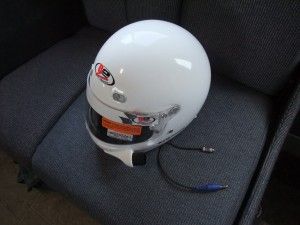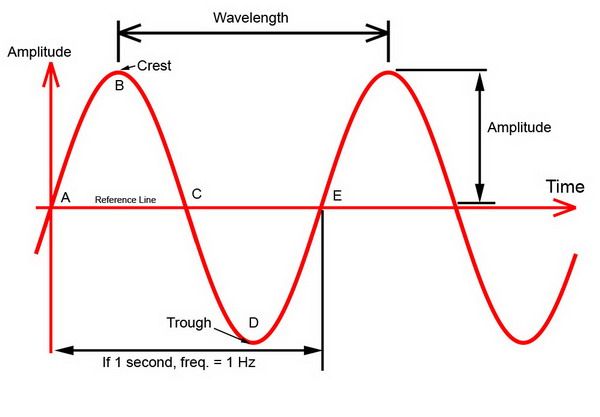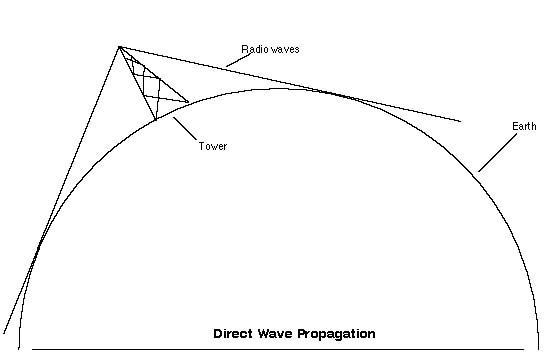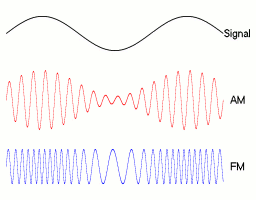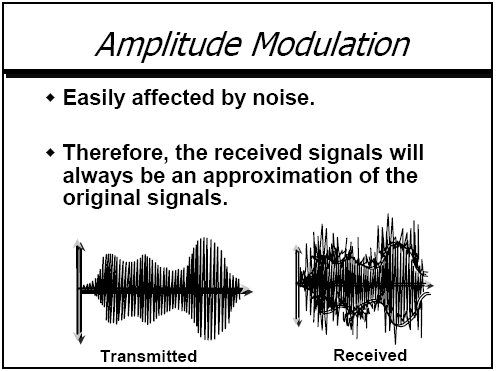 |
Two-way Radio Basic Theory
By Bill "BillaVista" Ansell |
Waves & The EM SpectrumRadio theory, antenna theory, electromagnetic propagation - all are advanced, complicated topics. I'm going to keep it short and sweet and try to cover only what you need to know to intelligently choose an offroad comms system. But we do have to cover a bit - because if you don't know a wavelength from a frequency, or UHF from VHF, you're going to be at a bit of a disadvantage. We'll start with some basic wave form physics and the electromagnetic (EM) spectrum - don't worry - it's mostly harmless. Two-way radios (that is, radios that can transmit and receive, allowing you to communicate) work by transmitting and receiving radio waves. Radio waves are a form of electromagnetic energy that are generated by one radio, transmitted by that radio's antenna, travel (or propagate) through the air, are intercepted (received) by another radio's antenna, and can then be heard on the receiving radio. The following diagram depicts many different types of radio waves and their uses. Waves transfer energy from one point to another without transferring matter. They consist of disturbances which transfer the energy in the direction the wave travels without transferring matter. A radio wave is a very complex form of EM energy containing both electric and magnetic fields that interact in complex ways with the Earth's atmosphere. The study of them is a whole branch of complicated physics. In order to keep this article to a reasonable length, and to keep the appeal as broad as possible, we're going to skip over a lot and just hit some highlights - so no letters from the physicists please! Properties of Radio WavesThe basic shape of the wave generated by a radio transmitter is that of a sine wave. A sine wave, as illustrated in this pic, has the following characteristics: CycleA continuous sine wave is composed of several repeating parts called "cycles". Points ABCDE comprise one complete cycle having a maximum value above, and a maximum value below, the reference line. The maximum value above the line is referred to as the TOP or CREST, and the maximum value below the line is called the BOTTOM or TROUGH, as depicted in the figure. Therefore, one cycle has one crest and one trough. WavelengthA wavelength is the distance in space occupied by one cycle of a radio wave at any given instant. If the wave could be frozen in place and measured, the wavelength would be the distance from the leading edge of one cycle to the corresponding point on the next cycle. Wavelengths vary from a few hundredths of an inch at extremely high frequencies to many miles at extremely low frequencies; however, common practice is to express wavelengths in meters. The distance between A and E is one wavelength. AmplitudeTwo waves may have the same wavelength, but the crest of one may rise higher above the reference line than the crest of another. The height of a wave crest above the reference line is called the amplitude of the wave. The amplitude of a wave gives a relative indication of the amount of energy the wave transmits - in other words the signal's strength.. FrequencyWhen a continuous series of waves passes through a medium (like air), a certain number of individual waves pass a given point in a specific amount of time. The number of cycles of a continuous wave per unit of time is called the frequency of the wave and is measured in Hertz. One Hertz (abbreviated Hz) is one cycle per second. Therefore, if 5 waves pass a point in one second, the frequency of the wave is 5 cycles per second or 5 Hz. One frequency with which we are all familiar is the frequency of normal household electrical current. In North America, this is 60 Hz. In the study of radio waves, the frequencies can get very high, so in addition to Hz we also use the units kilohertz (one thousand hertz) megahertz (one million hertz), and gigahertz (one billion hertz). 1,000,000 Hertz (Hz) = 1000 kilohertz (KHz) = 1 megahertz (MHz) = 0.1 gigahertz (GHz). Frequency and wavelength are related to one another by the following simple equations:
and
where the speed of light = 299 792 458 meters / second (roughly 300 million m/s ) Most often we talk about radio waves by frequency. A quick and dirty method to approximate the wavelength of a given radio frequency is to divide 300 by the frequency in MHz to get the wavelength in metres. For example, if Race Ops transmit on a frequency of 151.490 MHz, the wavelength of their transmissions is 300 / 151.490 = 1.980 metres (or about 2 metres). The following diagram illustrates waves with the same amplitude, but different wavelengths and therefore also different frequencies: Frequencies between 3000 hertz (3 KHz) and 300,000,000,000 hertz (300 GHz) are called radio frequencies since they are commonly used in radio communications. This part of the EM spectrum is divided into bands, each band being 10 times higher in frequency than the one immediately below it. The radio frequency bands are shown in the following table. Radio Frequency Bands
Here's a look at where these radio frequencies fit in the overall EM spectrum. Why is all this talk of wavelength and frequency important? Well, for the average user, it comes down to two things - range and clarity. That is - how far can I reach with my radio? And how clear will it be? The answers to these two questions depend on a lot of complicated inter-related factors - from power to antenna tuning to sun-spot activity and the curvature of the earth. But, the factors we can easily control that most affect range and clarity are wavelength (and therefore the frequency) and the power output of the radio. We'll cover these in more detail as they apply to choosing and buying a radio in a moment, but first we must briefly introduce the concepts of theoretical range, attenuation, and "line of sight". The wavelength of the radio wave has a huge effect on the range and clarity that can be achieved. In very simple terms, the longer the wavelength, the lower the frequency, and the greater the range. The physics behind why this is so are not terribly important to understand so we'll just accept it as fact. If it helps, imagine you have a rope between two people which you intend to use to send a signal between them. Imagine you intend to send that signal by flicking one end of the rope so as to send a wave down it. The longer the rope, the further your signal can reach, but the weaker it will be when it gets there (poorer quality). There's all kinds wrong with that analogy, so to keep me from going on for pages and to keep the physics boffins off my back, just remember that in general:
In the typical "nothing is free" nature of the universe, typically the longer the wavelength the poorer the quality of the signal and therefore the less clear it is. Think of a movie where you've seen military radio operators communicating over great distances, particularly over the horizon from one another (also known as "beyond line of sight or BLOS). The reception is spotty and full of static. There are delays, interference, and lots of "noise". Quality is poor and the operators speak in that funny sounding strict military way to make sure they are heard and understood. This is because, in order for the radio waves to transmit that far, they have to be long wavelength (low frequency) - typically in the HF range. Now, imagine a modern cellphone operating in the GHz frequency range - very short wavelength, very high frequency. Quality and clarity is excellent, but range is very poor - which is why you have to be within range of a "cellphone tower" to have service, and why the towers must be so high. So now we have:
Which brings us to the concept of "line of sight" range. What this means is that, theoretically, for radios that operate in the frequency range we are interested in (typically VHF and UHF), quality is very good, but because of the short-ish wavelengths, range is limited to direct line of sight (LOS) - that is, there must be an unobstructed path directly between the transmitting antenna and the receiving antenna. The direct LOS for two objects on the surface of the earth, providing there are no obstructions between them, is about 5 miles before the curvature of the earth gets in the way and begins to obscure one from the other. This is where antenna height comes into play - just like for the cell tower. It is easy to imagine that LOS is going to be a lot further if two people were perched at the top of two mountains than if they were sitting on surfboards on the ocean. On land, in other terrain, obviously this theoretical LOS range can very from several miles to mere feet. The following diagram illustrates the concept of LOS transmission and the advantage of antenna height. The equation for max theoretical range is: R = 1.4*(Sqrt(Ht) + Sqrt(Hr)) Where: R = the range in miles Ht = the height of the transmitting antenna in feet Hr = the height of the receiving antenna in feet So if your antennae are 6' off the ground, max theoretical range is about 1.4*(Sqrt(6) + Sqrt(6) = 6.8 miles But if they are 500' off the ground, max range increases to: 1.4*(Sqrt(500) + Sqrt(500) = 62 miles (assuming there are no obstructions). That's the theoretical maximum range. In practice, the propagation characteristics of these radio waves vary substantially depending on the exact frequency and the strength of the transmitted signal (a function of both the transmitter and the antenna characteristics). In reality, there are factors that can both add to and subtract from this range. Factors that reduce the range include:
Factors that increase range include:
The different radios we can buy and use are susceptible to these factors to a greater or lesser degree depending on the radio, and we'll cover how shortly. Of course, there are reasons other than these that may influence or even wholly dictate the choice we must make in terms of radio frequency band - chiefly what frequency do we need to use to be able to communicate with others? Once a radio that works in a particular frequency band is chosen, the key to getting more range is to either raise the height of the antenna, increase the power of the radio, or both. |
||||||||||||||||||||||||||||||||||||||||||||||||||
Two-way Radio BasicsOK, so we've covered the basics of radio waves so that we can now cover the basics of two-way radios - like those used off-road. We're all familiar with the type of radio we have in our daily driver cars. They operate using the same radio waves as we have described above. The difference is, they are receivers only - they receive the radio waves transmitted or "broadcast" by the radio station (which, for reasons we now understand, use tall antenna towers and high power). But they cannot transmit - so not very useful for two-way communications. A two-way radio, on the other hand, can both transmit and receive. Generally, two-way radios (hereafter referred to simply as "radios") , come in one of three flavours:
They all work the same way, but as we progress from hand-held up to stationary size, weight, power, and antenna size increase (and therefore range). Clearly, each has its specific purpose. The rest of this article shall concentrate on hand-held and mobile models as these are the most useful to us (even your "camp" or pit is rarely truly stationary). If you've ever used a CB radio or a walkie-talkie then you're already familiar with the basic features and method of operation of a radio - they work in essentially the same way. Common features include:
Handheld portable radios are designed for short-range communication between people or between a person and a mobile radio. They prioritize portability over range and therefore have small antennae and limited battery power. In the United States the Federal Communications Commission regulations state that handheld radios are limited to no more than 5 watts of power. Vehicle-mounted mobile two-way radios mount in a car or truck and are wired into the vehicle's electrical system for power. They have greater power and a larger external antenna mounted on the vehicle. Power is normally in the 50-100 watt range for a typical race radio. Desktop base station radios use wall AC power and an external-mounted antenna, often mounted on top of a building or even on a tower to increase range. Mobile radios can be used as base-station radios by connecting them to a convenient DC power source (a spare car battery) or by using an AC to DC power converter. Modulation and TransmissionOK, so radios use amplifiers and antennae to transmit electromagnetic energy (radio waves) back and forth through the atmosphere. But how does this let me talk back and forth with another radio user, and why do I care how it works. The answer to the second question is, because you have to know what type of radio you need - and one of the main differences between radios is something you're already familiar with - some are AM, some are FM, just like the radio in your daily driver car. We need to understand the difference between AM and FM for one of two reasons. Either:
And to understand the difference between AM and FM, we must first understand what modulation is (that's what the "M" in AM and FM stands for). And understanding modulation is the answer to how a radio actually lets you talk back and forth. Here's the super quick and dirty version of how it all works. Sound, produced by your voice (or your home theatre speakers), consists of physical vibrations in the air. If you could see the actual air molecules, you would see that they alternately bunch up together (a compression) and get spread out (a rarefaction). These are sound waves, created by the movement of your vocal chords, a stereo speaker's cone, or anything else that can compress air and therefore create sound. These sound waves also have frequency - ranging from 20Hz (deep bass) to 20 kHz (high treble). Human speech occurs in the 80Hz - 3 kHz range. In the case of simple communication through normal speech and hearing, one person's vocal chords create the sound waves, they travel through the air and vibrate the listeners eardrum back and forth which turns the sound waves into impulses the brain can read. Simple. When we introduce a radio to extend the range of communication, things get a little more complicated. Now, when the speaker speaks, the sound waves they create vibrate not an eardrum, but a thin membrane in the microphone. The microphone translates these vibrations into electrical impulses. These electrical signals are the sound, called the "information", that needs to get carried to the speaker of the radio on the receiving end so that they can operate in reverse and cause the speaker cone to vibrate back and forth, creating sound waves again, that then go on to vibrate the listener's ear drum. The "information" we want to send via radio (e.g. someone's voice) is called the baseband signal. So we have information that needs to be carried somewhere. This is where modulation comes in. Just like a letter needs a postman to carry it to its destination, so the sound information needs a carrier to carry it to the receiving radio. Only instead of using a guy with a mail bag, we use electromagnetic energy waves - radio waves. With me so far? Good. This is where modulation comes in. Modulation is simply a fancy word for changing something in order to encode it with information. In this case, modulating a carrier wave so that it is encoded with a baseband signal (sound information) that can be demodulated at the receiving end and the information, or sound, decoded and sent to the speaker and thence the listener's ear. A simple form of modulation is to think of a pen drawing a straight line across a piece of paper. The straight line is unmodulated, it carries and transmits no information. However, if you modulate (change / vary) the line by writing, then the line carries and transmits information. Back to radios. Recall that radio waves have both frequency and amplitude. Radio waves, like other waves, are measured by frequency, the number of times a wave varies above and below a reference point. In addition to frequency, radio waves also have amplitude. Amplitude describes the height or intensity of a given wave. The ability to manipulate variations in amplitude and frequency makes possible the modulation of the carrier radio wave. In other words, we modulate, or change, the frequency or the amplitude of the carrier wave, and by doing so we can code it with the information, (baseband signal) we wish it to carry. Thus, we have AM or "amplitude modulation" radio and FM or "frequency modulation" radio waves. AM vs. FMAM (amplitude modulation) varies the amplitude (intensity) of the carrier, while the frequency remains the same. FM (frequency modulation) encodes the sound information by changing the frequency, while the amplitude remains constant. This figure shows a simple baseband or signal sine wave, followed by a representation of what it might look like modulated by amplitude and by frequency, (AM and FM). Each method has its advantages and disadvantages, with one of the most important differences being the amount of bandwidth the chosen method consumes in the process. That is, how much of the EM spectrum is need to convey the modulated signal that consists of the combination of the information (the baseband signal) and the carrier signal. A precise description of the different modulation methods is beyond the scope of this article, so I'll just summarize some of the important differences. Keep in mind that these are generalizations and not absolutes. AM is the oldest and simplest form of modulation. AM is a well established and mature technology. AM is easy to generate, easy to demodulate, and consumes less bandwidth than FM. It can be done using low power and relatively cheap and simple equipment. However, AM is very sensitive to noise contamination (noise is any EM signal that is not wanted - like static). Because AM transmission varies the amplitude of the wave, and static interacts with the amplitude of radio waves, AM is more susceptible to interference from other EM energy which further contributes to reduced quality and reduced fidelity of the sound. That's the scratchy, crackly part of AM radio on your car stereo. AM is also limited by regulation and industry practice in that it is generally used for lower frequency transmissions - which means it generally has longer range than FM, but because of the resulting lower bandwidth allocated, isn't able to send as much information. That is, AM is unable to carry the full range of frequencies needed to reproduce high fidelity sound like music. Ever notice how most AM radio stations are all news, talk or sports (or really crappy music)? This is less of a problem with voice-only radio as in two-way radio use. FM is far more complex than AM. This means it requires more complex and expensive equipment (the modulation and demodulation are far more complex). Because the frequency is being changed, an FM signal consumes much more bandwidth than an AM signal - on the order of 10 to 20 times more. This greater bandwidth has its own pluses and minuses. On the plus side it means FM can support the transmission of more baseband frequency components, i.e. more information, higher fidelity sound. For example, commercial FM radio stations are each allocated a 180 kHz bandwidth which allows them to support a maximum baseband frequency of 15 kHz. On the other hand, commercial AM radio stations are each assigned to a 10 kHz channel which only allows them to support a maximum baseband frequency of 5 kHz. Recall that human hearing ranges from 20Hz to 20KHz and we see that better sound can be heard on FM (although voice-only communication doesn't really suffer from AM's lack of bandwidth). On the down side it also means that FM channels must be "wider" and therefore there are fewer of them in a given block of the EM spectrum (which can be a problem in the highly congested EM spectrum of today). By regulation and industry practice, FM transmissions are often (but not always) at higher frequencies (VHF & UHF) than their AM counterparts (HF & lower VHF) and thus even more limited to line of sight ranges than AM. Although more complex in design, FM offers better resistance to the effects of noise since it varies the frequency of the signal keeping the amplitude constant and therefore the modulation is not as susceptible to interference or being distorted. When a radio has more signal and less noise, we say it has a better signal-to-noise ration or greater SNR (you may have seen this term in radio or stereo specs). Ultimately, because of its greater bandwidth and better SNR, FM generally produces higher quality signals and therefore better quality sound. This following table illustrates a summary of the differences between AM and FM.
* - these characteristics are not strictly due to the modulation method alone, but are due to the frequencies commonly used with the type of modulation by convention, government regulator assignment, standard OEM design, or law. Two-way radio frequenciesSo, we've already touched on different frequencies. Let's take a brief look now at more specific radio frequencies. Two-way radios can operate on many different frequencies, and these frequencies are assigned differently in different countries.
Typically different frequencies are "channelized" - that is, a specific frequency is assigned a fixed channel number for a given type of radio, so that operators need not tune equipment to a particular frequency but instead can use one or more channels pre-set with the frequency, easily chosen by a push-button or other means. It is, for instance, easier to remember "Channel 1" than to remember "26.965 MHz" (CB Channel 1) or "156.05 MHz" (Marine channel 1). It is, of course, necessary to identify which radio service is under discussion when specifying a frequency by its channel number. This is a list of international Maritime channels The performance of a radio system is partly dependent on the characteristics of the frequency band used. The selection of a frequency for a two-way radio system is affected, in part, by:
This chart depicts frequency allocations in the United States. Note how incredibly "crowded" the EM spectrum is! Each country allocates radio frequencies to different two-way services, in accordance with international agreements. In the United States some examples of two-way services are: Citizen's Band (CB radio) , FRS, Marine, etc. This is an excellent article on frequency allocations. The following chart depicts some popular two-way radio services and their frequency allocations. 150 - 162 MHz: FM @ 15 kHz steps 150.815 - 150.965 Auto Emergency 150.995 - 151.595 Highway / Forestry / Industry 151.625 - 151.955 Business (30 kHz steps) 152.030 - 152.240 Mobile phone (Base) / Page (30 kHz steps) 152.270 - 152.450 Taxi (Base) 152.510 - 152.840 Mobile phone (Base) / Page (30 kHz steps) 152.870 - 153.725 Industry 153.740 - 154.445 Fire / Govt (mobile) 154.452 - 154.482 Industry (telemetry) (7.5 kHz steps) 154.490 - 154.625 Industry 154.650 - 156.240 Police / Govt / Emrgncy / Hwy 156.025 - 157.425 Maritime (ship) (25 kHz steps) 157.470 - 157.515 Auto Emergency 157.530 - 157.710 Taxi (mobile) / Business 157.770 - 158.100 Mobile phone (mobile) / Page (30 kHz steps) 158.130 - 158.460 Industry 158.490 - 158.700 Mobile phone (mobile) / Page (30 kHz steps) 158.730 - 159.210 Police / Govt / Highway 159.225 - 159.465 Forestry Conservation 159.495 - 160.200 Transportation - bus, truck 160.215 - 161.610 Railroad 160.625 - 160.950 Maritime - Coast (25 kHz steps) 161.640 - 161.760 {Broadcast Pickups
161.500 - 162.025 {Maritime - Coast (25 kHz steps)
UHF versus VHFThe two frequency bands most commonly used for two-way radios of the type we are interested in are VHF and UHF. Neither frequency band is inherently better than the other. Both formats are effective ways to communicate with another person so the right radio depends on the application. As we have learned, the frequency also determines the wavelength, and the wavelength has a big impact on radio performance. While both VHF and UHF are "line of sight" radios in theory, anyone who has used a two-way radio knows that in practice, it is possible to communicate with someone you can't see. The exact reasons are very complex, suffice to say that radio waves can penetrate certain solid barriers, they can also bend around obstacles, and "find there way through" obstacles (like trees) that are tightly spaced but not solid. How effectively they do this is largely a factor of the wavelength. Of course, greater power increases range for any wavelength, to a point (as does a properly sized and tuned antenna). VHF has a longer wavelength and as a general rule a VHF radio signal travels a greater distance. Lower frequencies (or longer wavelengths) have greater penetrating power. On the other hand, UHF has a shorter wavelength which makes it easier for the signal to find its way through rugged terrain and around obstacles. Imagine we are separated from the radio we wish to talk to by some mixed terrain with rocks and trees. Imagine the gaps between the trees are 3 feet wide. Imagine we are using a VHF radio transmitting a wavelength of 5 feet, and UHF radio transmitting a wavelength of 1.5 feet. The longer VHF wave will penetrate the trees and rocks better, but will not find its way through the trees as well since the wavelength is longer than the gaps between the trees. On the other hand, the UHF radio will have less penetrating power to get through the trees and rocks, but the signal will find its way around the trees and obstacles better since it is less than the gap between the obstacles. Imagine the wavelength is like a 2x4 strapped across your shoulders - if it's 5' long you can't fit between the trees, but if it's only 1.5' long, you can. Remember, both signals attenuate (loose strength) the further they go, and the more obstacles they encounter and get reflected off, refracted (bent) off, and absorbed by. Now, in a different scenario, imagine there are obstacles such as large boulders that are about 3 feet in diameter. Since they are larger than the UHF wavelength, they will block the UHF signal when it encounters them. Conversely, the larger 5 foot VHF wavelength, being larger than the boulders, will get around them better. The shape and composition (density) of obstacles have a large affect on how radio waves interact with them too. Smooth, rounded objects tend to deflect signals, whereas flat surfaces tend to reflect or absorb them. Dense materials such as metal tend to reflect signals, less dense material such as wood tend to absorb signals or let them pass, depending on the wavelength and power of the transmission. However, if a VHF wave and a UHF wave were transmitted over an area without barriers, the VHF wave would travel almost twice as far. There are more available channels with UHF so in more populated areas UHF may be less likely to have interference from other systems. Since the range of UHF is also not as far as VHF under most conditions, there is less chance of distant radios interfering with your signal. One other advantage of the short wavelength that is produced by the higher UHF frequency is that the antenna on the radio can be shorter than an equivalent VHF radio. That can make it more convenient in certain installations or to carry around as a portable radio. Since VHF has been around longer and isn’t as complicated to make, equipment can be cheaper when compared to similar UHF equipment. Simplex versus DuplexOne last thing we should discuss because you may come across it when researching radios is the difference between simplex and duplex operation. Simplex systems use a single frequency (channel) for both transmit and receive. This means you can't transmit and receive simultaneously - in other words, you can't talk and listen at the same time - you have to be doing one or the other. Most often, a push-to-talk (PTT) switch is activated to transmit, and then released when you want to listen. This is also known as "keying the mic" (microphone) when you want to talk. The thing is, whomever you're communication with has to do the same, in coordination with you. That is, if you both key the mic and try to talk at the same time neither of you will hear the other. This situation is handled by the use of certain "pro words" such as "over" so that both parties can work in sync. A duplex system, on the other hand, transmits and receives on different frequencies. A half-duplex system still requires the use of a PTT switch and operates much the same as a simplex radio. A full-duplex system however can both transmit and receive simultaneously and no PTT switch is required. Your average household telephone is duplex - you can talk and listen at the same time, so conversation can be more "natural" and less "formal". Duplex radio systems are expensive,complicated, and not of further interest to us here, although you may come across the term. SummaryThis concludes our look at the basics of radio theory and two-way radios. There are many different types of radios commercially available, and an understanding of the basics should help you make a good decision on what wil work best for you. |
|
